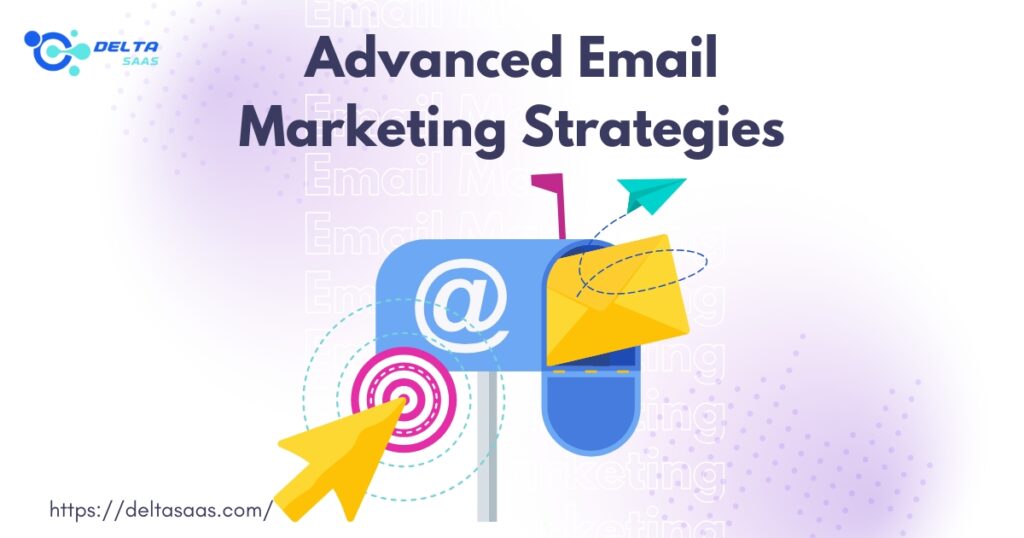10 Effective Advanced Email Marketing Strategies
Email marketing remains one of the most powerful tools for small businesses to connect with their target audience. With the right strategies, businesses can generate leads, build customer relationships, and drive sales. This blog explores 10 advanced email marketing strategies to help small businesses stay ahead in the competitive digital landscape.
Understanding the Power of Email Marketing
Email marketing is more than just sending promotional emails. It’s a data-driven approach that combines personalization, automation, and emerging technologies to deliver targeted messages. For small businesses, email marketing offers a cost-effective way to reach a wide audience while maintaining a personal touch.
Why Advanced Strategies Matter
Basic email marketing tactics may yield results, but advanced strategies go further. They focus on maximizing engagement, improving ROI, and leveraging marketing automation and predictive analytics tools. These strategies ensure that every email aligns with the customer’s needs and preferences.
Key Components of Advanced Email Marketing
Before diving into the strategies, it’s essential to understand the core components that make email marketing effective:
- Personalization: Tailoring emails to individual preferences and behaviors.
- Segmentation: Dividing the audience into smaller groups based on specific criteria.
- Automation: Using marketing software to send emails at the right time.
- Analytics: Tracking performance to refine future campaigns.
These components form the foundation of advanced email marketing strategies.
Leverage Advanced Segmentation
Segmentation is a critical aspect of email marketing. Advanced segmentation goes beyond basic demographics. It involves dividing the audience based on behavior, purchase history, and engagement levels.
How to Implement Advanced Segmentation
- Use data from past interactions to create targeted groups.
- Segment based on customer lifecycle stages (e.g., new subscribers, repeat customers).
- Apply predictive analytics to identify potential high-value customers.
Benefits of Advanced Segmentation
- Higher open and click-through rates.
- Improved customer satisfaction through relevant content.
- Increased sales by targeting the right audience with the right message.
Personalize Email Content
Personalization is no longer optional. Customers expect emails that speak directly to their needs and interests. Advanced personalization involves using dynamic content and AI-driven tools to create highly customized emails.
Tips for Effective Personalization
- Use the recipient’s name and location in the email.
- Recommend products based on past purchases.
- Send personalized offers and discounts.
Why Personalization Works
Personalized emails have been shown to deliver six times higher transaction rates. They make customers feel valued, leading to stronger relationships and increased loyalty.
Read More: How to Be Successful in Digital Marketing?
Use Marketing Automation
Marketing automation simplifies email sending while ensuring timely and relevant communication. It allows businesses to set up automated workflows based on customer actions.
Examples of Marketing Automation
- Welcome emails for new subscribers.
- Abandoned cart reminders.
- Re-engagement campaigns for inactive users.
Advantages of Automation
- Saves time and resources.
- Ensures consistent communication.
- Improves customer engagement through timely emails.
Focus on Data-Driven Decisions
Data is the backbone of advanced email marketing. By analyzing metrics like open rates, click-through rates, and conversions, businesses can refine their strategies for better results.
Key Metrics to Track
- Open Rate: The percentage of recipients who open the email.
- Click-Through Rate (CTR): The percentage of recipients clicking links within the email.
- Conversion Rate: The percentage of recipients who complete a desired action.
How to Use Data Effectively
- Identify trends and patterns in customer behavior.
- Test different email templates and subject lines.
- Adjust strategies based on performance insights.
Optimize for Mobile Devices
Most emails are opened on mobile devices, so optimizing for mobile is crucial. A mobile-friendly email ensures that the content is easily readable and actionable.
Tips for Mobile Optimization
- Use a responsive email template.
- Keep subject lines short and compelling.
- Use larger fonts and clear call-to-action buttons.
Impact of Mobile Optimization
- Higher engagement rates.
- Improved user experience.
- Increased likelihood of conversions.
Implement A/B Testing
A/B testing involves sending two versions of an email to a small audience segment to determine which performs better. It’s a proven way to optimize email campaigns.
What to Test
- Subject lines.
- Email copy and design.
- Call-to-action buttons.
Benefits of A/B Testing
- Identifies what resonates with the audience.
- Reduces guesswork in campaign planning.
- Increases overall campaign effectiveness.
Use AI and Predictive Analytics
Artificial intelligence and predictive analytics are transforming email marketing. These technologies help businesses anticipate customer needs and deliver highly targeted content.
Applications of AI in Email Marketing
- Predicting the best time to send emails.
- Recommending products based on customer behavior.
- Automating content creation for personalized emails.
Why AI Matters
- Enhances personalization and relevance.
- Improves campaign performance.
- Saves time and resources.
Create Engaging Content
Content is the heart of any email marketing campaign. Advanced strategies focus on creating content that is not only informative but also engaging and visually appealing.
Tips for Engaging Content
- Use storytelling to connect with the audience.
- Include visuals like infographics and videos.
- Keep the tone conversational and friendly.
Impact of Engaging Content
- Higher open and click-through rates.
- Increased brand loyalty.
- Better overall campaign performance.
Build a Strong Email List
A high-quality email list is essential for successful email marketing. Advanced strategies focus on growing and maintaining a list of engaged subscribers.
How to Build a Strong Email List
- Offer valuable content in exchange for email sign-ups.
- Use social media and website pop-ups to capture leads.
- Regularly clean the list to remove inactive subscribers.
Benefits of a Strong Email List
- Higher engagement rates.
- Improved deliverability.
- Better ROI on email campaigns.
Measure and Improve ROI
The ultimate goal of email marketing is to generate a positive return on investment. Advanced strategies focus on tracking and improving ROI through continuous optimization.
How to Measure ROI
- Calculate revenue generated from email campaigns.
- Compare the cost of campaigns to the revenue earned.
- Use analytics tools to track performance.
Tips for Improving ROI
- Focus on high-performing segments.
- Continuously test and refine strategies.
- Invest in tools and technologies that enhance campaign performance.
Enhancing Email Marketing with Emerging Technologies
Emerging technologies like artificial intelligence (AI), machine learning, and predictive analytics are reshaping email marketing. These SaaS tools enable businesses to create smarter, more effective campaigns that resonate with their target audience.
The Role of AI in Email Marketing
AI helps businesses analyze large amounts of data to identify patterns and trends. Based on customer behavior, AI can predict the best time to send emails or recommend products. This level of insight allows businesses to deliver highly personalized content.
Benefits of Predictive Analytics
Predictive analytics uses historical data to forecast future outcomes. Email marketing can help identify which customers are most likely to convert or churn. By leveraging this data, businesses can create targeted campaigns that drive results.
Examples of AI-driven email Marketing
- Dynamic Content: AI can generate personalized content for each recipient based on their preferences.
- Send Time Optimization: AI determines the optimal email time for maximum engagement.
- Behavioral Triggers: Automated emails are sent based on specific customer actions, such as browsing a product page.
Integrating Email Marketing with Other Digital Strategies
Email marketing works best when integrated with other digital strategies, such as social media, content marketing, and advertising. This holistic approach ensures a consistent brand message across all platforms.
Combining Email and Social Media
Social media platforms can be used to grow your email list and promote email campaigns. For example, businesses can run social media ads offering a free resource in exchange for email sign-ups.
Using Content Marketing to Boost Email Engagement
Content marketing and email marketing go hand in hand. Businesses can use email to share blog posts, videos, and other valuable content with their audience. This not only drives traffic to the website but also keeps subscribers engaged.
Leveraging Advertising for Email List Growth
Paid advertising can be an effective way to grow your email list. By targeting specific demographics, businesses can attract high-quality leads who are more likely to engage with their emails.
The Importance of Testing and Optimization
Testing and optimization are critical components of advanced email marketing. By continuously testing different elements of your campaigns, you can identify what works best and refine your strategies accordingly.
Key Elements to Test
- Subject Lines: Test different subject lines to see which ones generate the highest open rates.
- Email Design: Experiment with layouts, colors, and fonts to determine what resonates with your audience.
- Call-to-Action (CTA): Test different CTAs to see which drives the most clicks and conversions.
Benefits of Continuous Optimization
- Improved campaign performance.
- Higher engagement and conversion rates.
- Better understanding of your audience’s preferences.
Building Trust and Authority Through Email Marketing
Trust and authority are essential for building long-term relationships with your audience. Advanced email marketing strategies focus on delivering value and establishing your brand as a trusted resource.
How to Build Trust
- Be transparent about how you use customer data.
- Provide valuable content that addresses your audience’s needs.
- Consistently deliver on your promises by sending exclusive offers or helpful tips.
Establishing Authority
- Share industry insights and thought leadership content.
- Highlight customer success stories and testimonials.
- Position your brand as an expert in your niche.
The Future of Email Marketing
The future of email marketing lies in integrating advanced technologies and focusing on personalization. As customer expectations evolve, businesses must adapt their strategies to stay relevant.
Trends to Watch
- Interactive Emails: Emails with interactive elements like polls, quizzes, and videos.
- AI-Powered Personalization: More sophisticated personalization using AI and machine learning.
- Privacy-First Marketing: Greater emphasis on data privacy and compliance with regulations like GDPR.
Preparing for the Future
- Invest in tools and technologies that enhance personalization and automation.
- Stay updated on industry trends and best practices.
- Continuously test and refine your strategies to meet changing customer needs.
The Role of Customer Feedback in Email Marketing
Customer feedback is a valuable resource for refining email marketing strategies. By listening to your audience, you can gain insights into their preferences, pain points, and expectations. This information can be used to create more relevant and engaging email campaigns.
How to Collect Customer Feedback
- Surveys: Include short surveys in your emails to gather feedback on your campaigns.
- Reviews and Testimonials: Encourage customers to leave reviews or share their experiences.
- Social Media: Monitor social media platforms for comments and mentions related to your brand.
Using Feedback to Improve Campaigns
- Tailor content based on customer preferences.
- Address common pain points in your emails.
- Highlight positive feedback to build trust and credibility.
The Power of Storytelling in Email Marketing
Storytelling is a powerful tool for connecting emotionally with your audience. By sharing stories, you can make your emails more engaging and memorable.
How to Incorporate Storytelling
- Share customer success stories or case studies.
- Use narratives to explain the benefits of your products or services.
- Create a series of emails that tell a story over time.
Benefits of Storytelling
- Builds an emotional connection with your audience.
- Makes your brand more relatable and human.
- Increases engagement and retention rates.
Leveraging User-Generated Content
User-generated content (UGC) is any content your customers create, such as reviews, photos, or social media posts. Incorporating UGC into your email campaigns can boost credibility and engagement.
How to Use UGC in Emails
- Feature customer reviews or testimonials.
- Share photos or videos submitted by customers.
- Create campaigns that encourage customers to share their experiences.
Advantages of UGC
- Builds trust and authenticity.
- Encourages community engagement.
- Provides fresh and relatable content.
The Importance of Email Deliverability
Email deliverability refers to the ability of your emails to reach the recipient’s inbox. Poor deliverability can significantly impact the success of your campaigns.
Tips to Improve Deliverability
- Use a reputable email service provider.
- Regularly clean your email list to remove inactive subscribers.
- Avoid spammy subject lines and content.
- Authenticate your emails using SPF, DKIM, and DMARC protocols.
Monitoring Deliverability Metrics
- Bounce Rate: The percentage of emails that could not be delivered.
- Spam Complaints: The number of recipients marking your emails as spam.
- Inbox Placement Rate: The percentage of emails that land in the inbox rather than the spam folder.
Creating a Consistent Email Schedule
Consistency is key to maintaining engagement with your audience. A regular email schedule helps build anticipation and keeps your brand top-of-mind.
Read More: Strong Building Customer Relationships for Success
How to Establish a Schedule
- Determine the optimal frequency based on your audience’s preferences.
- Use automation tools to schedule emails in advance.
- Balance promotional emails with value-driven content.
Benefits of a Consistent Schedule
- Builds trust and reliability.
- Improves open and click-through rates.
- Encourages long-term engagement.
The Role of Visuals in Email Marketing
Visual elements like images, videos, and infographics can make your emails more engaging and effective. They help convey information quickly and leave a lasting impression.
Best Practices for Using Visuals
- Use high-quality images that align with your brand.
- Incorporate videos to demonstrate products or share stories.
- Create infographics to present data in an easy-to-understand format.
Impact of Visuals
- Increases email engagement and click-through rates.
- Enhances the overall aesthetic of your emails.
- Makes complex information more digestible.
Building Long-Term Relationships Through Email
Email marketing is not just about driving immediate sales; it’s also about building long-term relationships with your audience. By focusing on customer retention, you can create a loyal customer base that supports your business over time.
Strategies for Building Relationships
- Send personalized thank-you emails after purchases.
- Celebrate milestones like birthdays or anniversaries with special offers.
- Share exclusive content or early access to new products.
Benefits of Long-Term Relationships
- Increases customer lifetime value.
- Encourages repeat purchases and referrals.
- Strengthens brand loyalty and trust.
The Role of Email Marketing in the Customer Journey
Email marketing is crucial at every customer journey stage, from awareness to advocacy. You can guide customers toward conversion and beyond by tailoring your emails to each stage.
Emails for Each Stage
- Awareness: Educational content and lead magnets.
- Consideration: Product comparisons and case studies.
- Purchase: Discounts and limited-time offers.
- Retention: Follow-up emails and loyalty programs.
- Advocacy: Requests for reviews and referrals.
Benefits of a Customer-Centric Approach
- Improves the overall customer experience.
- Increases the likelihood of conversions.
- Encourages long-term loyalty and advocacy.
Learn More,
Email A/B Testing Mistakes to Avoid
Email Deliverability Issues: Causes & Fixes
How to Improve Conversion Rate in Email Campaigns
Why Is Email Marketing Ineffective? Common Issues
Automated Email Marketing: Boost Campaign Success
Final Thoughts
Advanced email marketing strategies are essential for small businesses looking to stand out in a competitive digital landscape. By leveraging personalization, automation, and emerging technologies, businesses can create campaigns that resonate with their audience and drive meaningful results.
Remember, the key to success lies in continuous testing, optimization, and focusing on delivering value. As customer expectations evolve, so should your email marketing strategies. Stay ahead of the curve by embracing new trends and technologies, and always prioritize your audience’s needs and preferences.
FAQs
What are the 5 T’s of email marketing?
The five Ts of email marketing are Targeting, Timing, Tone, Testing, and Tracking. These elements help create effective campaigns that resonate with the audience.
What is the rule of 7 in email marketing?
The rule of 7 states that a customer needs to see or hear a message at least seven times before taking action. Email marketing means sending consistent, value-driven emails to build trust and familiarity.
What is the best email marketing strategy?
The best email marketing strategy depends on your business goals and audience. However, the most effective strategy often involves personalization, segmentation, and automation.
What is advanced segmentation in email marketing?
Advanced segmentation involves dividing your email list into smaller groups based on specific criteria, such as behavior, preferences, and purchase history. This allows for more targeted and relevant campaigns.
How can small businesses benefit from email marketing?
Small businesses can use email marketing to build relationships, generate leads, and drive sales. It’s a cost-effective way to reach a wide audience while maintaining a personal touch.
What tools are best for email marketing automation?
Popular tools for email marketing automation include Mailchimp, HubSpot, and ActiveCampaign. These platforms offer features like automated workflows, analytics, and personalization.
How can I improve my email open rates?
To improve open rates, craft compelling subject lines, personalize your emails, and send them at the optimal time.
What is the role of AI in email marketing?
AI helps businesses analyze data, predict customer behavior, and automate content creation and send-time optimization tasks.
How do I measure the success of my email campaigns?
Success can be measured using metrics like open rates, click-through rates, conversion rates, and ROI. Regularly analyze these metrics to refine your strategies.
Why is mobile optimization important in email marketing?
Mobile optimization ensures that emails are easily readable and actionable on mobile devices, where most emails are opened.


